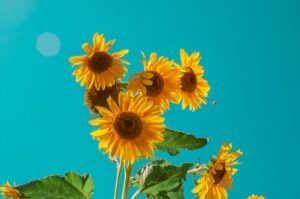Wildflowers are a diverse group of flowering plants that grow in their natural habitats without any human intervention. They are often associated with open meadows, fields, and forests, but can be found in a variety of environments around the world. What sets wildflowers apart from cultivated flowers is their ability to adapt to their surroundings and thrive in diverse conditions.
The appeal of wildflowers lies in their natural beauty and the sense of wonder they evoke. Unlike cultivated flowers, which are often bred for specific traits such as size or color, wildflowers come in a wide range of shapes, sizes, and colors. From delicate orchids to vibrant sunflowers, there is a wildflower for every taste and preference.
Key Takeaways
- Wildflowers play an important role in ecosystems and beyond, providing food and habitat for wildlife and contributing to the overall health of the environment.
- Beginner botanists can use tips and tricks to identify wildflowers, such as observing the shape and color of the flower and examining the leaves and stem.
- Natural habitats and gardens are great places to find wildflowers, with different species blooming at different times throughout the year.
- Understanding bloom cycles is key to seeing the best display of wildflowers, with peak times varying depending on the species and location.
- Photography and sketching are great ways to capture the beauty of wildflowers, with tips such as using natural light and getting up close for detail.
The Importance of Wildflowers: Their Role in Ecosystems and Beyond
Wildflowers play a crucial role in ecosystems around the world. They provide food and habitat for a variety of insects, birds, and other animals. Many species of butterflies and bees rely on wildflowers for nectar and pollen, making them essential for pollination. In turn, these pollinators help to fertilize the flowers and ensure their reproduction.
Wildflowers also have cultural and historical significance. They have been used for centuries in traditional medicine, as well as in religious and cultural ceremonies. In many cultures, wildflowers are seen as symbols of beauty, purity, and resilience.
From an economic perspective, wildflowers have value as well. They attract tourists and nature enthusiasts who come to admire their beauty and explore their natural habitats. This can boost local economies through increased tourism revenue.
Identifying Wildflowers: Tips and Tricks for Beginner Botanists
Identifying wildflowers can be a challenging task, especially for beginners. However, with some basic knowledge and observation skills, anyone can learn to identify different species of wildflowers.
One of the first steps in identifying wildflowers is to familiarize yourself with the basic characteristics of different plant families. This can help narrow down the possibilities when trying to identify a specific flower. Field guides and smartphone apps can be valuable tools in this process, providing detailed descriptions and images of different species.
When observing wildflowers, it is important to pay attention to details such as the shape and arrangement of leaves, the color and shape of petals, and the overall structure of the plant. These characteristics can provide clues about the identity of the flower.
Where to Find Wildflowers: Exploring Natural Habitats and Gardens
| Location | Number of Wildflower Species | Best Time to Visit |
|---|---|---|
| Mountains | Over 100 | Spring and Summer |
| Deserts | 50-60 | Spring |
| Grasslands | 50-60 | Summer and Fall |
| Wetlands | Over 100 | Spring and Summer |
| Gardens | Varies | Depends on Planting |
Wildflowers can be found in a variety of natural habitats, including meadows, prairies, woodlands, and wetlands. Each habitat has its own unique set of wildflower species, adapted to the specific conditions of that environment.
One way to explore wildflowers is by visiting botanical gardens and nature reserves. These protected areas often have designated wildflower gardens or trails where visitors can see a wide variety of species in one place. Botanical gardens also provide educational resources and programs for those interested in learning more about wildflowers.
When exploring natural habitats, it is important to respect the environment and follow any rules or regulations in place. Avoid picking or disturbing wildflowers, as this can disrupt their natural growth and reproduction.
The Best Time to See Wildflowers: Understanding Bloom Cycles
Wildflowers have different bloom cycles depending on the species and environmental conditions. Some flowers bloom in early spring, while others bloom in late summer or fall. Understanding these bloom cycles can help you plan your wildflower viewing trips more effectively.
Factors such as temperature, rainfall, and sunlight can affect the timing and duration of wildflower blooms. In general, spring is a popular time to see wildflowers, as many species bloom during this season. However, there are also plenty of flowers that bloom in summer and fall.
The best times to see wildflowers can vary depending on the region. In some areas, wildflowers may bloom earlier or later than in others. Local botanical societies and nature centers can provide information on the best times to see wildflowers in your area.
Capturing Wildflowers: Tips for Photography and Sketching

Photographing and sketching wildflowers can be a rewarding way to capture their beauty and preserve the memory of your encounters with them. Whether you are using a camera or a sketchbook, there are some tips and techniques that can help you create stunning images or drawings of wildflowers.
When photographing wildflowers, it is important to pay attention to lighting and composition. Soft, diffused light is often best for capturing the delicate details of flowers. Experiment with different angles and perspectives to create interesting compositions.
If you are sketching wildflowers, take your time to observe the details of the flower before putting pencil to paper. Start with a rough outline and gradually add more details as you go. Don’t worry about making a perfect representation; instead, focus on capturing the essence and character of the flower.
Wildflowers and Wildlife: Discovering the Interconnectedness of Nature
Wildflowers play a vital role in supporting wildlife populations. They provide food and habitat for a variety of animals, including insects, birds, and mammals. Many species of butterflies and bees rely on wildflowers for nectar and pollen, making them essential for pollination.
Creating habitats for wildlife is an important way to support biodiversity and preserve ecosystems. By planting native wildflowers in your garden or creating natural habitats in your community, you can help provide food and shelter for a variety of species.
Preserving biodiversity is crucial for maintaining healthy ecosystems and ensuring the survival of both wildflowers and wildlife. By protecting natural habitats from destruction and advocating for conservation efforts, individuals can make a significant impact on preserving wildflower populations.
Cultivating Wildflowers: Creating a Garden of Native Plants
Cultivating native wildflowers in your garden can not only enhance the beauty of your outdoor space but also provide important resources for pollinators and other wildlife. Native wildflowers are adapted to the local climate and soil conditions, making them more resilient and easier to care for.
When starting a wildflower garden, it is important to choose the right plants for your region. Consider factors such as sunlight, soil type, and water availability when selecting species. Local nurseries and botanical gardens can provide guidance on suitable native wildflowers for your area.
Maintaining a wildflower garden requires some basic care, such as regular watering, weeding, and pruning. However, native wildflowers are generally low-maintenance and can thrive with minimal intervention. By cultivating native wildflowers, you can create a beautiful and sustainable garden that supports local ecosystems.
The Medicinal Properties of Wildflowers: Traditional and Modern Uses
Wildflowers have been used for centuries in traditional medicine for their healing properties. Many cultures around the world have relied on wildflowers to treat various ailments and promote overall well-being.
Modern research has also shed light on the medicinal properties of wildflowers. Many species contain compounds that have been found to have anti-inflammatory, antimicrobial, and antioxidant effects. Some wildflowers are used in the production of herbal remedies, skincare products, and dietary supplements.
It is important to use wildflowers responsibly and consult with a healthcare professional before using them for medicinal purposes. Some species may have toxic or allergenic properties, and improper use can lead to adverse effects.
Preserving Wildflowers: Advocating for Conservation and Sustainability
Wildflowers face numerous threats, including habitat loss, climate change, pollution, and invasive species. Conservation efforts are crucial for preserving these beautiful and important plants for future generations.
Individuals can play a role in promoting conservation and sustainability by supporting organizations that work to protect wildflower habitats, participating in citizen science projects, and advocating for policies that prioritize environmental protection.
In addition, individuals can make a difference by making sustainable choices in their daily lives. Planting native wildflowers, reducing pesticide use, conserving water, and supporting local farmers and businesses are all ways to promote sustainability and protect wildflower populations.
In conclusion, wildflowers are not just beautiful flowers that dot the landscape; they play a vital role in ecosystems, have cultural and historical significance, and offer numerous benefits to humans and wildlife alike. By understanding and appreciating wildflowers, we can contribute to their preservation and ensure that future generations can continue to enjoy their beauty.
If you’re a fan of wildflowers and looking for some light-hearted entertainment, you won’t want to miss this article on Tom Smothers, a comedy pioneer and musical maestro. Discover how Smothers’ unique blend of humor and music captivated audiences for decades. From his iconic television show to his memorable performances, this article delves into the life and career of a true comedic legend. So, take a break from the wildflower fields and indulge in some laughter by clicking here to read more about Tom Smothers.




















+ There are no comments
Add yours